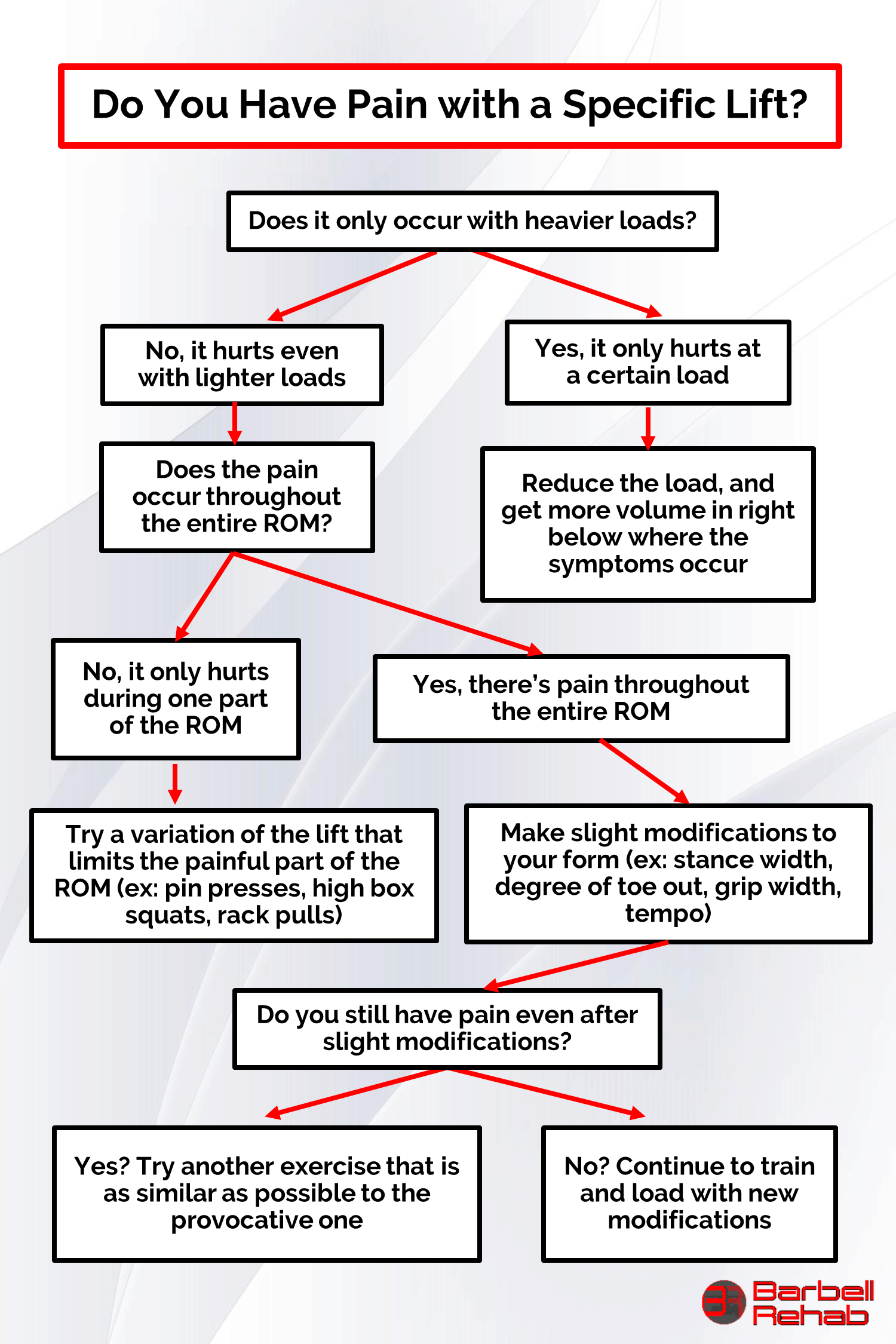Pain during a lift can be a very frustrating experience. Some decide to push through it and hope for the best, while others immediately avoid it in fear that they will permanently damage something. The answer often lies somewhere in the middle. In this article, I’m going to show you exactly what to do if you’re experiencing pain during a specific compound, multi-joint lift.
This ideology is an algorithmic approach, based on my 4 Step Framework to Training with Pain. If you find this interesting, I recommend downloading that to gain an even deeper understanding of this methodology.
Whether you’re having shoulder pain with the bench press, hip pain with the squat, or back pain during the deadlift, this approach will work (barring any serious underlying medical condition).
You can see an overview of this process based on the image below:

Does the Pain Only Occur with Heavier Loads?
Many times pain during a lift only hurts when you’re using higher weights, or heavier intensities. The solution for this usually involves training right BELOW the pain threshold and getting more volume in at a tolerable intensity. If you consistently train through the pain, your body may not be able to adapt to it appropriately, which will make it linger around longer. If you skip the lift all together, you won’t be giving it any stimulus at all to adapt to!
Here’s an example of this concept for shoulder pain during a bench press. Let’s say that you’re training the bench press at 4 sets of 8 today and you’re supposed to use 185 lbs. You’re doing your warm-up sets and notice that shoulder pain starts at 165 lbs. So you back the weight down a tad and find out that 155 lbs feels better. Today would be a great day to do 5 sets of 8 at 155 lbs. See how I ADDED an extra set at a lower and more tolerable intensity? This will essentially keep your volume stable, continue to elicit a training effect, and prevent flare ups.
Overall, the trick here is to get more volume in just below the pain threshold, so you can slowly increase that threshold over time until you’re back at baseline. Sometimes this is all you need to do to overcome pain with a specific lift!
The Exercise Even Hurts With Lighter Loads
Sometimes, when you’re dealing with pain during a lift, it hurts to even do it with warm-up weights or bodyweight. One good example of this would be hip pain during squats. When someone has a hip pinch at the bottom of their squat, it usually hurts regardless of how much weight is on the bar.
Another example would be shoulder pain at the bottom of the bench press. This is another case where the front of the shoulder hurts during a bench press, regardless of how much weight. In this case, you need to ask yourself this:
“Does it only hurt at the BOTTOM portion of the lift, or does it feel achy and painful throughout?”
First, let’s cover what to do if it hurts only at the bottom of the lift.
Pain Only at the Bottom of the Lift
The best thing to do when you only have pain at the bottom of the lift is to use a variation of the lift that either de-stresses or completely eliminates the painful portion.
For the bench press, the example being shoulder pain at the bottom of the lift, suitable variations (with linkable videos) for this may include:
For the squat, you can perform a box squat, set at a height right above where you’re having pain. Train it at the higher height for a few weeks, and then gradually lower the box until you’re back down to the depth that you want to train at.
For the deadlift, let’s use back pain as an example. Usually you can limit the bottom portion of the deadlift to allow you train in a more tolerable fashion by using variations such as the high-handled trap bar deadlift or rack pulls.
And for the overhead press, you can train a seated overhead barbell press from the pins in a rack, set at a height right ABOVE where you’re having shoulder pain.
As you can see, there are a TON of options you have if you’re only having pain during the bottom part of the lift. None of these options include giving up training all together!
For Pain that Occurs Throughout Most of the ROM
This is the time that you want to make some slight modifications to your form to help offload sensitized structures. For the squat, you can modify your stance width, degree of toe out or bar position.
For the bench press, you can change your grip width and the amount of shoulder abduction.
And for the deadlift, you can try sumo instead of conventional (or vice versa), change your stance width with the sumo, or adjust the tempo as well.
These slight modifications to form can make DRASTIC reductions in pain. That’s why it’s really important to not force everyone to perform a lift the same! Everyone is different!
When Form Modifications Don’t Work
Sometimes making slight adjustments to form don’t work. In this case it may be best to remove the painful exercise all together and train a variation that’s similar to it, but doesn’t hurt.
The key here is that you only want to regress the movement enough to reduce the pain, not change the entire movement pattern. For example, if you’re having pain with the bench press, it wouldn’t make sense to regress all the way to a push-up if you can bench press pain free with a slight incline.
Even when you do change the movement, you can still manipulate joint angles to find that optimal form for you!
As you can see. There are so many things you can do when you have pain during a lift that doesn’t involve NOT training. With the exception of some sort of serious medical condition or sickness, there’s always a way to modify your lifts to continue to elicit a training effect!

